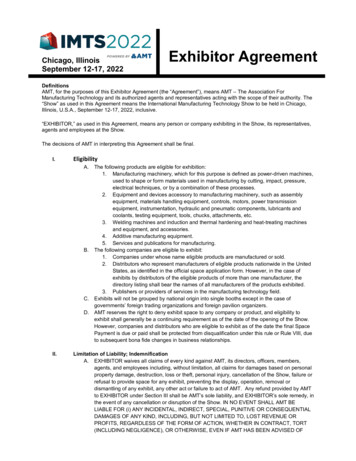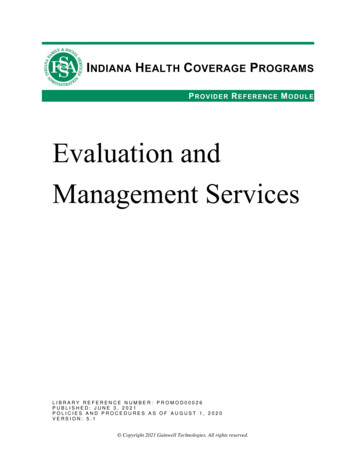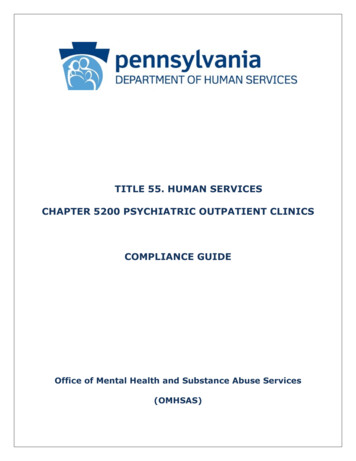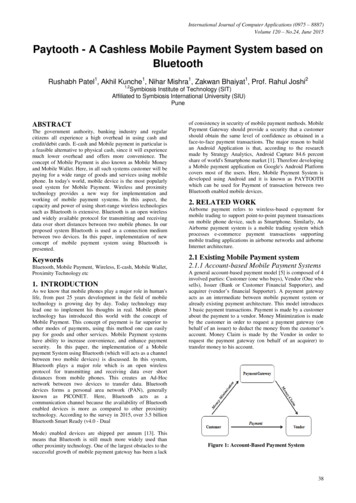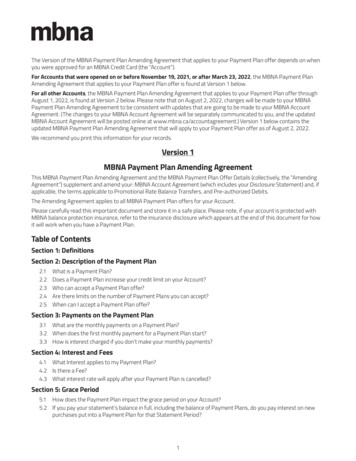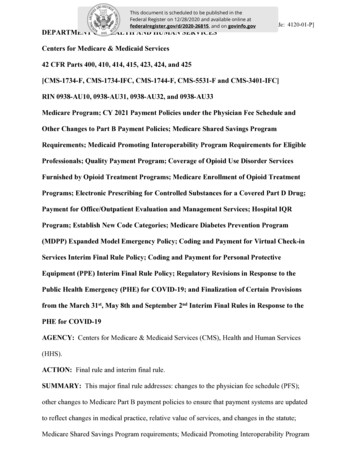
Transcription
This document is scheduled to be published in theFederal Register on 12/28/2020 and available online at[Billingfederalregister.gov/d/2020-26815, and on govinfo.govCode: 4120-01-P]DEPARTMENT OF HEALTH AND HUMAN SERVICESCenters for Medicare & Medicaid Services42 CFR Parts 400, 410, 414, 415, 423, 424, and 425[CMS-1734-F, CMS-1734-IFC, CMS-1744-F, CMS-5531-F and CMS-3401-IFC]RIN 0938-AU10, 0938-AU31, 0938-AU32, and 0938-AU33Medicare Program; CY 2021 Payment Policies under the Physician Fee Schedule andOther Changes to Part B Payment Policies; Medicare Shared Savings ProgramRequirements; Medicaid Promoting Interoperability Program Requirements for EligibleProfessionals; Quality Payment Program; Coverage of Opioid Use Disorder ServicesFurnished by Opioid Treatment Programs; Medicare Enrollment of Opioid TreatmentPrograms; Electronic Prescribing for Controlled Substances for a Covered Part D Drug;Payment for Office/Outpatient Evaluation and Management Services; Hospital IQRProgram; Establish New Code Categories; Medicare Diabetes Prevention Program(MDPP) Expanded Model Emergency Policy; Coding and Payment for Virtual Check-inServices Interim Final Rule Policy; Coding and Payment for Personal ProtectiveEquipment (PPE) Interim Final Rule Policy; Regulatory Revisions in Response to thePublic Health Emergency (PHE) for COVID-19; and Finalization of Certain Provisionsfrom the March 31st, May 8th and September 2nd Interim Final Rules in Response to thePHE for COVID-19AGENCY: Centers for Medicare & Medicaid Services (CMS), Health and Human Services(HHS).ACTION: Final rule and interim final rule.SUMMARY: This major final rule addresses: changes to the physician fee schedule (PFS);other changes to Medicare Part B payment policies to ensure that payment systems are updatedto reflect changes in medical practice, relative value of services, and changes in the statute;Medicare Shared Savings Program requirements; Medicaid Promoting Interoperability Program
requirements for Eligible Professionals; updates to the Quality Payment Program; Medicarecoverage of opioid use disorder services furnished by opioid treatment programs; Medicareenrollment of Opioid Treatment Programs; payment for office/outpatient evaluation andmanagement services; Requirement for Electronic Prescribing for Controlled Substances for aCovered Part D drug under a prescription drug plan or an MA-PD plan and Medicare DiabetesPrevention Program (MDPP) expanded model Emergency Policy. This final rule also finalizescertain provisions of the interim final rules with comment period that CMS issued on March 31,2020, May 8, 2020, and September 2, 2020 in response to the Public Health Emergency (PHE)for the Coronavirus Disease 2019 (COVID-19). This rule also establishes coding and paymentfor virtual check-in services and for personal protective equipment (PPE) on an interim finalbasis.DATES: Effective Date: The regulations in the final rule are effective on January 1, 2021.Applicability date: The policies in this final rule are applicable on January 1, 2021, except asfollows:(1) The revisions to 42 CFR 400.200 and 425.611(b)(1)(ii) are applicable retroactively tothe start of the PHE for COVID-19 on January 27, 2020. (See discussions in sections II.J. andIII.G.5.d.(2) of this final rule, respectively.)(2) The revisions to 42 CFR 425.400(c)(2) are applicable retroactively for theperformance year starting on January 1, 2020. (See discussion in section III.G.5.e.(3) of thisfinal rule.)Comment date: Comments will be accepted/considered ONLY on the “Interim Final Rule withComment Period for Coding and Payment of Virtual Check-in Services” contained in sectionII.D. of the preamble of this document and “Interim Final Rule with Comment Period for Codingand Payment for Personal Protective Equipment (PPE)” contained in section II.H. of thepreamble of this document. To be assured consideration, comments must be received at one ofthe addresses provided below, no later than 5 p.m. on February 1, 2021.
ADDRESSES: In commenting, please refer to file code CMS-1734-IFC.Comments, including mass comment submissions, must be submitted in one of thefollowing three ways (please choose only one of the ways listed):1. Electronically. You may submit electronic comments on this regulation tohttp://www.regulations.gov. Follow the "Submit a comment" instructions.2. By regular mail. You may mail written comments to the following address ONLY:Centers for Medicare & Medicaid Services,Department of Health and Human Services,Attention: CMS-1734-IFC,P.O. Box 8016,Baltimore, MD 21244-8016.Please allow sufficient time for mailed comments to be received before the close of the commentperiod.3. By express or overnight mail. You may send written comments to the followingaddress ONLY:Centers for Medicare & Medicaid Services,Department of Health and Human Services,Attention: CMS-1734-IFC,Mail Stop C4-26-05,7500 Security Boulevard,Baltimore, MD 21244-1850.FOR FURTHER INFORMATION CONTACT: Jamie Hermansen, (410) 786-2064, for anyissues not identified below.Michael Soracoe, (410) 786-6312, for issues related to practice expense, work RVUs,conversion factor, PFS specialty-specific impacts, and the interim final rule with comment periodfor coding and payment for PPE.
Larry Chan, (410) 786-6864, for issues related to potentially misvalued services under thePFS.Emily Yoder, (410) 786-1804, Donta Henson, (410) 786-1947, and Patrick Sartini, (410)786-9252, for issues related to telehealth, other services involving communications technology,and interim final rule with comment period for coding and payment of virtual check-in services.Liane Grayson, (410) 786-6583, for issues related to care management services andremote physiologic monitoring services.Emily Yoder, (410) 786-1804, Christiane LaBonte, (410) 786-7237, Ann Marshall, (410)786-3059, and Patrick Sartini, (410) 786-9252, for issues related to payment for office/outpatientevaluation and management visits.Christiane LaBonte, (410) 786-7237, and Cindy Bergin, (401) 786-1176, for issuesrelated to teaching physician services.Roberta Epps, (410) 786-4503, and Regina Walker-Wren, (410) 786-9160, for issuesrelated to supervision of diagnostic tests.Ann Marshall, (410) 786-3059, for issues related to incident to pharmacist services.Gift Tee, (410) 786-9316, for issues related to therapy services.Sarah Leipnik, (410) 786-3933, for issues related to medical record documentation.Lindsey Baldwin, (410) 786-1694 and Terry Simananda, (410) 786-8144, for issuesrelated to Medicare coverage of opioid use disorder treatment services furnished by opioidtreatment programs.Laura Ashbaugh, (410) 786-1113, for issues related to Clinical Laboratory Fee Schedule:Revised Data Reporting Period and Phase-in of Payment ReductionsJoseph Schultz, (410) 786-2656, for issues related to opioid treatment program providerenrollment regulation updates for institutional claim submissions.Lisa Parker, (410) 786-4949, for issues related to RHCs and FQHCs, primary caremanagement services, and the FQHC market basket.
Rachel Katonak, (410) 786-8564, or JoAnna Baldwin (410) 786-7205, for issues relatedto comprehensive screenings for seniors: Section 2002 of the Substance Use-Disorder Preventionthat Promote Opioid Recovery and Treatment for Patients and Communities Act (SUPPORTAct).David Koppel, (303) 844-2883, or Elizabeth LeBreton (202) 615-3816 for issues relatedto the Medicaid Promoting Interoperability Program.Fiona Larbi, (410) 786-7224, or Sabrina Ahmed, (410) 786-7499, for issues related to theMedicare Shared Savings Program (Shared Savings Program) Quality performance standard,quality reporting requirements and finalization of Shared Savings Program provisions from theMarch 31st COVID-19 IFC.Janae James, (410) 786-0801, or Elizabeth November, (410) 786-4518, orSharedSavingsProgram@cms.hhs.gov, for issues related to Shared Savings Program beneficiaryassignment, repayment mechanism requirements, and finalization of Shared Savings Programprovisions from the May 8th COVID-19 IFC.Cheryl Gilbreath, (410) 786-5919, for issues related to home infusion therapy benefit.Heather Hostetler, (410) 786-4515 for issues related to removal of selected nationalcoverage determinations.Joella Roland, (410) 786-7638, for issues related to requirement for electronic prescribingfor controlled substances for a covered Part D drug under a prescription drug plan or an MA-PDplan.Edmund Kasaitis, (410) 786-0477, for issues related to Part B drug payment and FoodDrug & Cosmetic Act section 505(b)(2) drug products.Elizabeth Holland, (410) 786-1309, for issues related to updates to certified electronichealth record technology due to the 21st Century Cures Act.Julia Venanzi, (410) 786-1471, for issues related to the Hospital Inpatient QualityReporting (IQR) Program
Cynthia Hake, (410) 786-3404, for issues related to HCPCS Level II codes.Amanda Rhee, (410) 786-3888, for the Medicare Diabetes Prevention Program (MDPP)expanded model emergency policy.Molly MacHarris, (410) 786-4461, for inquiries related to Merit-based Incentive PaymentSystem (MIPS).Brittany LaCouture, (410), 786-0481, for inquiries related to Alternative Payment Models(APMs).Patricia Taft, (410) 786-4561, for issues related to the Physician Self-Referral Law:Annual Update to the List of CPT/HCPCS Codes.SUPPLEMENTARY INFORMATION:Inspection of Public Comments: All comments received before the close of the comment periodare available for viewing by the public, including any personally identifiable or confidentialbusiness information that is included in a comment. We post all comments received before theclose of the comment period on the following Web site as soon as possible after they have beenreceived: http://www.regulations.gov. Follow the search instructions on that Web site to viewpublic comments. CMS will not post on Regulations.gov public comments that make threats toindividuals or institutions or suggest that the individual will take actions to harm the individual.CMS continues to encourage individuals not to submit duplicative comments. We will postacceptable comments from multiple unique commenters even if the content is identical or nearlyidentical to other comments.Addenda Available Only Through the Internet on the CMS Website: The PFS Addenda alongwith other supporting documents and tables referenced in this final rule are available on the CMSwebsite at icePayment/PhysicianFeeSched/index.html. Click on the link on the left side of the screen titled,“PFS Federal Regulations Notices” for a chronological list of PFS Federal Register and otherrelated documents. For the CY 2021 PFS final rule, refer to item CMS-1734-F. Readers with
questions related to accessing any of the Addenda or other supporting documents referenced inthis final rule and posted on the CMS website identified above should contact Jamie Hermansenat (410) 786-2064.CPT (Current Procedural Terminology) Copyright Notice: Throughout this final rule, we useCPT codes and descriptions to refer to a variety of services. We note that CPT codes anddescriptions are copyright 2019 American Medical Association. All Rights Reserved. CPT is aregistered trademark of the American Medical Association (AMA). Applicable FederalAcquisition Regulations (FAR) and Defense Federal Acquisition Regulations (DFAR) apply.I. Executive SummaryA. PurposeThis major final rule revises payment polices under the Medicare PFS and makes otherpolicy changes, including to the implementation of certain provisions of the Bipartisan BudgetAct of 2018 (BBA of 2018) (Pub. L. 115-123, February 9, 2018) and the Substance Use-DisorderPrevention that Promotes Opioid Recovery and Treatment (SUPPORT) for Patients andCommunities Act (the SUPPORT Act) (Pub. L. 115-271, October 24, 2018), related to MedicarePart B payment. In addition, this final rule includes provisions related to other payment policychanges that are addressed in sections III. and IV. of this final rule.We are issuing an interim final rule with comment period (IFC) to establish coding andpayment for virtual check-in services to support the continuing need for coding and payment toreflect the provision of lengthier audio-only services outside of the PHE for COVID-19, if not assubstitutes for in-person services, then as a tool to determine whether an in-person visit isneeded, particularly as beneficiaries may still be cautious about exposure risks associated within-person services. We are also issuing an interim final rule with comment period to establishcoding and payment for PPE as a bundled service and certain supply pricing increases inrecognition of the increased market-based costs for certain types of PPE.1. Summary of the Major Provisions
The statute requires us to establish payments under the PFS based on national uniformrelative value units (RVUs) that account for the relative resources used in furnishing a service.The statute requires that RVUs be established for three categories of resources: work; practiceexpense (PE); and malpractice (MP) expense. In addition, the statute requires that we establishby regulation each year’s payment amounts for all physicians’ services paid under the PFS,incorporating geographic adjustments to reflect the variations in the costs of furnishing servicesin different geographic areas.In this major final rule, we are establishing RVUs for CY 2021 for the PFS to ensure thatour payment systems are updated to reflect changes in medical practice and the relative value ofservices, as well as changes in the statute. This final rule also includes discussions andprovisions regarding several other Medicare Part B payment policies.Specifically, this final rule addresses: Practice Expense RVUs (section II.B.) Potentially Misvalued Services Under the PFS (section II.C.) Telehealth and Other Services Involving Communications Technology, and theInterim Final Rule with Comment Period for Coding and Payment for Virtual Check-in Services(section II.D.) Care Management Services and Remote Physiologic Monitoring Services (sectionII.E.) Refinements to Values for Certain Services to Reflect Revisions to Payment forOffice/Outpatient Evaluation and Management (E/M) Visits and Promote Payment Stabilityduring the PHE for COVID-19 (section II.F.) Scopes of Practice and Related Issues (section II.G.) Valuation of Specific Codes, and the Interim Final rule with Comment Period forCoding and Payment for Personal Protective Equipment (PPE) (section II.H.)
Modifications related to Medicare Coverage for Opioid Use Disorder (OUD) ServicesFurnished by Opioid Treatment Programs (OTPs) (section II.I.) Technical Correction to the Definition of Public Health Emergency (section II.J.) Clinical Laboratory Fee Schedule (section III.A.) Opioid Treatment Program Provider Enrollment Regulation Updates for InstitutionalClaim Submissions(section III.B.) Payment for Primary Care Management Services in RHCs and FQHCs (section III.C.) Changes to the Federally Qualified Health Center Prospective Payment System(FQHC PPS) for CY 2021: Rebasing and Revising of the FQHC Market Basket (section III.D.) Comprehensive Screenings for Seniors: Section 2002 of the Substance Use-DisorderPrevention that Promote Opioid Recovery and Treatment for Patients and Communities Act(SUPPORT Act) (section III.E.) Medicaid Promoting Interoperability Program Requirements for Eligible Professionals(EPs) (section III.F.) Medicare Shared Savings Program (section III.G.) Notification of Infusion Therapy Options Available Prior to Furnishing Home InfusionTherapy Services (section III.H.) Modifications to Quality Reporting Requirements and Comment Solicitation onModifications to the Extreme and Uncontrollable Circumstances Policy for Performance Year2020 (section III.I.) Removal of Selected National Coverage Determinations (section III.J.) Requirement for Electronic Prescribing for Controlled Substances for a Covered PartD drug under a prescription drug plan or an MA-PD plan (section III.K.) Medicare Part B Drug Payment for Drugs Approved Through the Pathway EstablishedUnder Section 505(b)(2) of the Food, Drug, and Cosmetic Act (section III.L.)
Updates to Certified Electronic Health Record Technology Requirements in thePromoting Interoperability Program, Quality Payment Program, and Hospital Inpatient QualityReporting Program due to the 21st Century Cures Act (section III.M.) Establishing New Code Categories (section III.N.) Medicare Diabetes Prevention Program (MDPP) expanded model emergency policy(section III.O.) Updates to the Quality Payment Program (section IV.) Physician Self-Referral Law: Annual Update to the List of CPT/HCPCS Codes(section V.) Waiver of Delay in Effective Date for this Final Rule (section VI.) Collection of Information Requirements (section VII.) Regulatory Impact Analysis (section VIII.)2. Provisions Related to the PHE for COVID-19The United States is currently responding to an outbreak of respiratory disease caused bya novel (new) coronavirus. This virus has been named “severe acute respiratory syndromecoronavirus 2” (“SARS-CoV–2”), and the disease it causes has been named “coronavirus disease2019” (“COVID–19”). On January 31, 2020, the Secretary determined that a PHE existednationwide as a result of the consequences of the COVID–19 pandemic (hereafter referred to asthe PHE for COVID–19). On March 13, 2020, President Trump declared the COVID-19pandemic a national emergency. Effective, October 23, 2020, the Secretary renewed the January31, 2020 determination that a PHE exists and has existed since January 27, 2020. (Note: Thisdeclaration was previously renewed on April 21, 2020 and July 25, 2020.)As the healthcare community continues to establish and implement recommendedinfection prevention and control practices, regulatory agencies operating under appropriatewaiver authority during the PHE for COVID-19 are also working to revise and implementregulations that support these healthcare community infection prevention and treatment
practices. We addressed some of these regulations in three previous interim final rules withcomment period (IFCs): The “Medicare and Medicaid Programs; Policy and Regulatory Revisions in Responseto the COVID-19 Public Health Emergency” IFC appeared in the April 6, 2020 FederalRegister (85 FR 19230) with an effective date of March 31, 2020 (hereafter referred to as the“March 31st COVID-19 IFC”); The “Medicare and Medicaid Programs, Basic Health Program, and Exchanges;Additional Policy and Regulatory Revisions in Response to the COVID-19 Public HealthEmergency and Delay of Certain Reporting Requirements for the Skilled Nursing FacilityQuality Reporting Program” IFC appeared in the May 8, 2020 Federal Register (85 FR 27550)with an effective date of May 8, 2020 (hereafter referred to as the “May 8th COVID-19 IFC”);and The “Medicare and Medicaid Programs, Clinical Laboratory ImprovementAmendments (CLIA), and Patient Protection and Affordable Care Act; Additional Policy andRegulatory Revisions in Response to the COVID-19 Public Health Emergency” IFC appeared inthe September 2, 2020 Federal Register (85 FR 54820) with an effective date of September 2,2020 (hereinafter referred to as the “September 2nd COVID-19 IFC).In this final rule, we are finalizing certain provisions of the March 31st, May 8th, andSeptember 2nd COVID-19 IFCs.We indicated in the CY 2021 PFS proposed rule (85 FR 50140 and 50147) our intent thatfor certain provisions of the March 31st, May 8th, and September 2nd COVID-19 IFCs, we wouldrespond to comments received in this final rule. In this final rule, we are responding to publiccomments and finalizing certain provisions of the March 31st, May 8th, and September 2ndCOVID-19 IFCs.3. Summary of Costs and Benefits
We have determined that this final rule is economically significant. For a detaileddiscussion of the economic impacts, see section VIII. of this final rule.4. Waiver of the 60-day Delay in Effective Date for the Final RuleThe United States is responding to an outbreak of respiratory disease caused by a novel(new) coronavirus that has now been detected in more than 190 locations internationally,including in all 50 States and the District of Columbia. The virus has been named “SARS CoV2” and the disease it causes has been named “Coronavirus disease 2019” (abbreviated“COVID-19”).Due to the significant devotion of resources to the COVID-19 response, as discussed insection VI. of the preamble of this final rule, we are hereby waiving the 60-day delay in theeffective date for this final rule as proposed, and replacing it with a 30-day delay in the effectivedate for this final rule.
II. Summary of the Proposed Provisions, Analysis of and Response to Public Comments,and the Provisions of the Final Rule for the PFSA. BackgroundSince January 1, 1992, Medicare has paid for physicians’ services under section 1848 ofthe Social Security Act (the Act), “Payment for Physicians’ Services.” The PFS relies onnational relative values that are established for work, practice expense (PE), and malpractice(MP), which are adjusted for geographic cost variations. These values are multiplied by aconversion factor (CF) to convert the relative value units (RVUs) into payment rates. Theconcepts and methodology underlying the PFS were enacted as part of the Omnibus BudgetReconciliation Act of 1989 (Pub. L. 101-239, enacted on December 19, 1989) (OBRA ’89), andthe Omnibus Budget Reconciliation Act of 1990 (Pub. L. 101-508, enacted on November 5,1990) (OBRA ’90). The final rule published in the November 25, 1991 Federal Register(56 FR 59502) set forth the first fee schedule used for payment for physicians’ services.We note that throughout this final rule, unless otherwise noted, the term “practitioner” isused to describe both physicians and nonphysician practitioners (NPPs) who are permitted to billMedicare under the PFS for the services they furnish to Medicare beneficiaries.1. Development of the RVUsa. Work RVUsThe work RVUs established for the initial fee schedule, which was implemented onJanuary 1, 1992, were developed with extensive input from the physician community. Aresearch team at the Harvard School of Public Health developed the original work RVUs formost codes under a cooperative agreement with the Department of Health and Human Services(HHS). In constructing the code-specific vignettes used in determining the original physicianwork RVUs, Harvard worked with panels of experts, both inside and outside the federalgovernment, and obtained input from numerous physician specialty groups.
As specified in section 1848(c)(1)(A) of the Act, the work component of physicians’services means the portion of the resources used in furnishing the service that reflects physiciantime and intensity. We establish work RVUs for new, revised and potentially misvalued codesbased on our review of information that generally includes, but is not limited to,recommendations received from the American Medical Association/Specialty Society RelativeValue Scale Update Committee (RUC), the Health Care Professionals Advisory Committee(HCPAC), the Medicare Payment Advisory Commission (MedPAC), and other publiccommenters; medical literature and comparative databases; as well as a comparison of the workfor other codes within the Medicare PFS, and consultation with other physicians and health careprofessionals within CMS and the federal government. We also assess the methodology and dataused to develop the recommendations submitted to us by the RUC and other public commenters,and the rationale for their recommendations. In the CY 2011 PFS final rule with commentperiod (75 FR 73328 through 73329), we discussed a variety of methodologies and approachesused to develop work RVUs, including survey data, building blocks, crosswalk to key referenceor similar codes, and magnitude estimation. More information on these issues is available in thatrule.b. Practice Expense RVUsInitially, only the work RVUs were resource-based, and the PE and MP RVUs werebased on average allowable charges. Section 121 of the Social Security Act Amendments of 1994(Pub. L. 103-432, enacted on October 31, 1994), amended by section 1848(c)(2)(C)(ii) of the Actand required us to develop resource-based PE RVUs for each physicians’ service beginningin 1998. We were required to consider general categories of expenses (such as office rent andwages of personnel, but excluding MP expenses) comprising PEs. The PE RVUs continue torepresent the portion of these resources involved in furnishing PFS services.Originally, the resource-based method was to be used beginning in 1998, but section4505(a) of the Balanced Budget Act of 1997 (Pub. L. 105-33, enacted on August 5, 1997) (BBA
‘97) delayed implementation of the resource-based PE RVU system until January 1, 1999. Inaddition, section 4505(b) of the BBA ‘97 provided for a 4-year transition period from thecharge-based PE RVUs to the resource-based PE RVUs.We established the resource-based PE RVUs for each physicians’ service in theNovember 2, 1998 final rule (63 FR 58814), effective for services furnished in CY 1999. Basedon the requirement to transition to a resource-based system for PE over a 4-year period, paymentrates were not fully based upon resource-based PE RVUs until CY 2002. This resource-basedsystem was based on two significant sources of actual PE data: the Clinical Practice ExpertPanel (CPEP) data; and the AMA’s Socioeconomic Monitoring System (SMS) data. These datasources are described in greater detail in the CY 2012 PFS final rule with comment period (76FR 73033).Separate PE RVUs are established for services furnished in facility settings, such as ahospital outpatient department (HOPD) or an ambulatory surgical center (ASC), and innonfacility settings, such as a physician’s office. The nonfacility RVUs reflect all of the directand indirect PEs involved in furnishing a service described by a particular HCPCS code. Thedifference, if any, in these PE RVUs generally results in a higher payment in the nonfacilitysetting because in the facility settings some resource costs are borne by the facility. Medicare’spayment to the facility (such as the outpatient prospective payment system (OPPS) payment tothe HOPD) would reflect costs typically incurred by the facility. Thus, payment associated withthose specific facility resource costs is not made under the PFS.Section 212 of the Balanced Budget Refinement Act of 1999 (Pub. L. 106-113, enactedon November 29, 1999) (BBRA) directed the Secretary of Health and Human Services (theSecretary) to establish a process under which we accept and use, to the maximum extentpracticable and consistent with sound data practices, data collected or developed by entities andorganizations to supplement the data we normally collect in determining the PE component. OnMay 3, 2000, we published the interim final rule (65 FR 25664) that set forth the criteria for the
submission of these supplemental PE survey data. The criteria were modified in response tocomments received, and published in the Federal Register (65 FR 65376) as part of aNovember 1, 2000 final rule. The PFS final rules published in 2001 and 2003, respectively,(66 FR 55246 and 68 FR 63196) extended the period during which we would accept thesesupplemental data through March 1, 2005.In the CY 2007 PFS final rule with comment period (71 FR 69624), we revised themethodology for calculating direct PE RVUs from the top-down to the bottom-up methodologybeginning in CY 2007. We adopted a 4-year transition to the new PE RVUs. This transition wascompleted for CY 2010. In the CY 2010 PFS final rule with comment period, we updated thepractice expense per hour (PE/HR) data that are used in the calculation of PE RVUs for mostspecialties (74 FR 61749). In CY 2010, we began a 4-year transition to the new PE RVUs usingthe updated PE/HR data, which was completed for CY 2013.c. Malpractice RVUsSection 4505(f) of the BBA ‘97 amended section 1848(c) of the Act to require that weimplement resource-based MP RVUs for services furnished on or after CY 2000. Theresource-based MP RVUs were implemented in the PFS final rule with comment periodpublished November 2, 1999 (64 FR 59380). The MP RVUs are based on commercial andphysician-owned insurers’ MP insurance premium data from all the states, the District ofColumbia, and Puerto Rico.d. Refinements to the RVUsSection 1848(c)(2)(B)(i) of the Act requires that we review RVUs no less often thanevery 5 years. Prior to CY 2013, we conducted periodic reviews of work RVUs and PE RVUsindependently. We completed 5-year reviews of work RVUs that were effective for calendaryears 1997, 2002, 2007, and 2012.Although refinements to the direct PE inputs initially relied heavily on input from theRUC Practice Expense Advisory Committee (PEAC), the shifts to the bottom-up PE
methodology in CY 2007 and to the use of the updated PE/HR data in CY 2010 have resulted insignificant refinements to the PE RVUs in recent years.In the CY 2012 PFS final rule with comment period (76 FR 73057), we finalized aproposal to consolidate reviews of work and PE RVUs under section 1848(c)(2)(B) of the Actand reviews of potentially misvalued codes under section 1848(c)(2)(K) of the Act into oneannual process.In addition to the 5-year reviews, beginning for CY 2009, CMS and the RUC identifiedand reviewed a number of potentially misvalued codes on an annual basis based on variousidentification screens. This annual review of work and PE RVUs for potentially misvaluedcodes was supplemented by the amendments to section 1848 of the Act, as enacted by section3134 of the Affordable Care Act, that require the agency to periodically identify, review andadjust values for potentially misvalued codes.e. Application of Budget Neutrality to Adjustments of RVUsAs described in section VIII. of th
ADDRESSES: In commenting, please refer to file code CMS-1734-IFC. Comments, including mass comment submissions, must be submitted in one of the following three ways (please choose only one of the ways listed): . PFS specialty-specific impacts, and the interim final rule with comment period for coding and payment for PPE. Larry Chan, (410) 786 .







